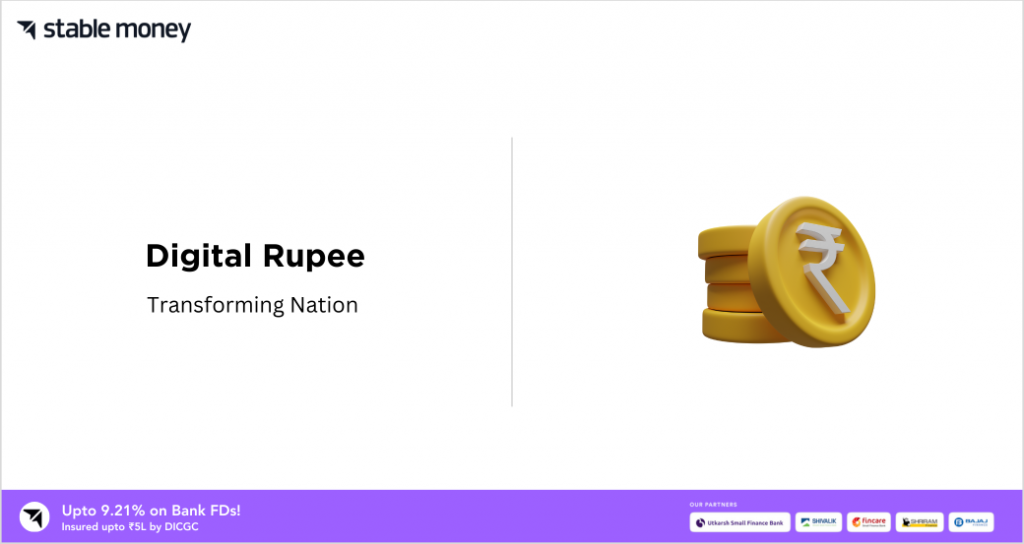
Digital rupee is the new digital currency the Reserve Bank of India introduced in India. It aims to leverage the advantages of blockchain technology for instant, cheaper and secure currency transactions. This blog explains the digital rupee, how it will work, key differences with other currencies, and issues around adopting Central Bank-issued Digital Currency.
What is the Meaning of Digital Rupee?
Digital rupee is India’s virtual currency to be issued by the Reserve Bank of India. It will exist in both retail and wholesale form. Retail digital rupees will be similar to physical coins and currency notes and can be used by consumers for day-to-day transactions. At the same time, the wholesale digital rupee will be employed by banks for settlements of interbank transactions.
Example of Digital Rupee
Introducing the digital rupee aims to make transactions safer, secure, simple, and convenient. It will also reduce the dependency on physical cash. With the digital rupee, people can make payments online to merchants using their bank accounts without needing physical currency. It aims to tap the benefits of blockchain technology for a safe, cheap and faster currency system.
Working of Digital Rupee?
The RBI will issue a digital rupee to banks, which will further distribute it to individuals and corporations. Users will get a digital rupee as a balance in their digital rupee wallets with the respective banks. Transactions will occur through online payments from these wallets like any other UPI or wallet payment.
What is the Digital Rupee Wallet?
A digital rupee wallet will be an electronic record maintained by banks to record how much digital rupee individuals and organisations hold. Users will need a digital wallet app to make and receive payments in digital rupee. Transactions will happen between wallets, much like any other digital payment method.
How to Register For Digital Rupee Wallet?
Registering for a digital rupee wallet will allow users to transact in the new digital currency introduced by the RBI. The process is simple and brief:
- Step 1: Download the app of your bank offering a digital rupee wallet
- Step 2: Complete the signup using your know-your-customer (KYC) details like name, address, etc already registered with the bank
- Step 3: Verify your identity by OTP or other secure means
- Step 4: Set up a security PIN or password for login
- Step 5: Your wallet is ready to receive and make digital rupee payments
What is CBDC
Central Bank Digital Currency is a digital form of fiat money issued by the central bank and used widely as a medium of exchange.
Different Types of CBDC
- Retail CBDC – Used by individuals for daily transactions. Accessible directly to the general public.
- Wholesale CBDC – Used for large-value, inter-bank settlements. Accessible only for banks and other financial institutions.
Main Challenges & Concerns of CBDC
While CBDC promises several benefits, there are some challenges and concerns around its adoption:
1. Challenges
- Technology challenge: Develop robust blockchain or other technology on which CBDC can function efficiently.
- Interoperability: Ensuring the CBDC system interacts seamlessly with existing payment systems.
2. Concerns
- Privacy: Concerns around how the anonymity of transactions is maintained in CBDC.
- Disintermediation: Cutting out the role of commercial banks in payment systems affecting their business.
- Cybersecurity: There is a high risk of hacking and securing large value transfers happening over digital currency networks.
- Geopolitics: Global power shift if a country’s CBDC becomes globally adopted, undermining other currencies.
How to Redeem Digital Rupee?
- Loading digital rupee: Through bank transfers, users can load digital rupee into their digital wallets. They can transfer funds from their linked savings or current bank accounts into the digital rupee wallet. Banks will also credit digital rupees into clients’ wallets directly during inter-bank settlements. Cash deposits at bank branches against issuing digital rupee is another way to load the balance.
- Redeeming digital rupee: Users can redeem or convert the digital rupee back to cash or traditional currency. They can visit their bank branches to redeem spare digital currency for cash. Another method is transferring digital rupee balances to associated bank accounts for future withdrawals or expenditures. Banks also facilitate the redemption process by buying back digital rupee holdings from clients’ digital wallets and crediting equivalent funds in their accounts. The process aims to make the loading and redemption of digital rupees simple.
How to Acquire Digital Rupee?
Users can get a digital rupee by opening an account with banks participating in the digital rupee project. The banks will credit digital rupees into customers’ newly created digital wallets against their existing cash balance with the bank.
Which Authority in India Issues Digital Rupee?
The Reserve Bank of India (RBI) will be the sole issuer of the digital rupee. It will distribute the digital currency to banks and other financial institutions and further disburse it to individuals and corporations engaging in digital rupee transactions.
What are the Uses of Digital Rupee?
Here are the uses of the digital rupee:
- Business-to-Business – The digital rupee can facilitate easy and instant business-to-business payments between companies through a unified account-based system without multiple intermediaries.
- Business-to-Consumer – Customers can use the digital rupee for various consumer purchases from retailers and merchants through a single tap on their mobile phones.
- Customer-to-Customer – People can instantly send and receive digital money from others in their social circles through dedicated peer-to-peer fund transfer applications.
What is the Share Price of the Digital Rupee?
The digital rupee, being the Central Bank Digital Currency, will have a fixed value equivalent to its physical version issued by the RBI. It is a digital alternative to banknotes and hence is not traded on exchanges or has any share price like private cryptocurrencies in the market.
What is Cryptocurrency?
Cryptocurrency is a digital medium of exchange like Bitcoin and Ethereum that uses cryptography for security and decentralisation for user authentication and management instead of a central regulatory body.
How Cryptocurrency is Different From Digital Rupee?
While cryptocurrency aims to be a completely decentralised currency outside government control, the Reserve Bank of India issues and regulates the digital rupee. As a legal tender, the digital rupee will have a stable value equal to fiat currency, but cryptocurrency prices are very volatile as per market demand. Also, the digital rupee will be used for retail transactions, while cryptocurrency is currently used more for investments and trading purposes globally.
Importance of the Digital Rupee
The Reserve Bank of India recently announced plans to launch a central bank digital currency (CBDC) called digital rupee. This could change how people use currency and banks operate in India. Here are some reasons why the digital rupee is important:
- It will give people more payment options as the digital rupee can be used like cash. This will promote a less cash economy.
- Digital currency makes transactions faster and more convenient as there is no need to carry around physical cash. Payments can be made anytime on a smartphone or other devices.
- Security of transactions also increases as digital rupee payments require authentication through mechanisms like OTP, unlike cash, which can be lost or stolen.
- It increases financial inclusion for common citizens as digital payments do not require bank accounts and can be done using mobile phones.
- The digital economy and startups would get a boost with innovations in the digital rupee and blockchain technology powering financial applications.
Characteristics & Features of the Digital Rupee
The digital rupee system developed by the Reserve Bank of India will have some unique characteristics compared to physical cash. Here are some of the expected characteristics and features:
1. Characteristics
- Donegerized and electronic forms of currency are unlike printed notes and coins.
- It is backed by RBI the same way physical cash is backed, ensuring its legal tender status.
2. Features
- Accessible on digital/mobile wallets using apps on smartphones.
- Peer-to-peer transfer facility without involving banks.
- Offline usability even without internet in select cases.
- Calculate interest for wallets holding a digital rupee balance with banks.
- Two-factor authentication for secure access and transfer of funds.
Advantages & Disadvantages of Digital Rupee
Like any new technology, the proposed digital rupee will have advantages and disadvantages. Let’s look at the key pros and cons:
1. Advantages
- Cost-effective transactions without service charges like ATM or banking fees.
- Help achieve financial inclusion by enabling digital payments without bank accounts.
- Secure mode of storing and sending money with two-factor authentication.
- Easy tracking of payments and less dependence on cash help curb black money.
- Faster execution of transactions through digital means compared to checks/drafts.
2. Disadvantages
- It requires smartphones and digital infrastructure, which may only be there for some.
- Technical glitches or server downtime can cause payment disruptions.
- The threat of cybersecurity breaches and hacking of digital wallets.
- Possible tracking of all financial activities by authorities.
- Volatility in the value of balances held due to fluctuations in exchange rates.
Final word
The digital rupee promises various benefits like financial inclusion, lower transaction costs and security compared to physical cash. However, its successful adoption will depend on how user’s privacy and consent are managed along with meeting technological challenges. Over time, as more uses emerge, the digital rupee could dominate over physical cash.
FAQs
The Digital Rupee is the digital form of the Indian currency launched by RBI. It differs from cryptocurrencies because the central bank issues it, acts as a legal tender and aims to facilitate transactions and store value.
Digital currency offers many benefits – it allows faster payments through smartphones, reduces costs of global money transfers, provides continuous access without depending on bank timings, does away with printing physical notes and coins, and helps automate the distribution of subsidies and benefits directly to citizens.
Some challenges with the Digital Rupee are that it is complex to choose suitable virtual currencies, transactions could be costly due to heavy electricity usage, users may find it difficult to adapt initially, and concerns remain about protecting systems from cyberattacks and hacks.
Disclaimer
This article is solely for educational purposes. Stable Money doesn't take any responsibility for the information or claims made in the blog.
